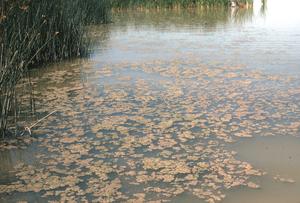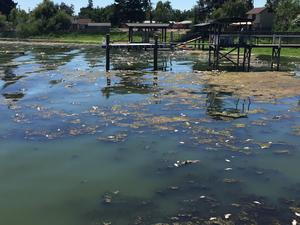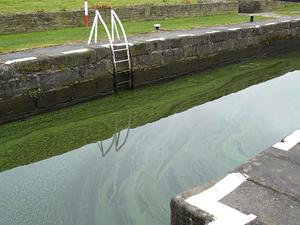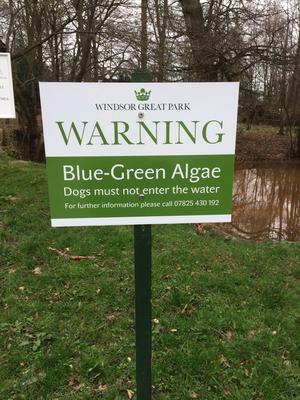Blue-green algae and its dangers to dogs
Blue-green algae can be highly poisonous, or even fatal to dogs, so it's important that you don’t let your dog drink from or swim in water containing blue-green algae.
What is blue-green algae?
Blue-green algae is a term used to describe a group of bacteria, called cyanobacteria. They are not actually algae, but the organisms got this name because they often give the appearance of algae when they clump together in bodies of water.
Blue-green algae is most common in non-flowing, fresh water such as lakes, ponds and rivers. Certain conditions such as hot summer weather can cause it to thrive and grow rapidly, forming a 'bloom' of blue-green algae on the water. It can also be seen during other times of the year.
Some types of blue-green algae contain toxins that can are highly poisonous and often fatal to pets. It can also cause illness in people if touched or swallowed.
Important
Call your vet immediately if you think your dog has swallowed water containing blue-green algae. The sooner they receive treatment, the higher their chances of recovery.
What does blue-green algae look like?
Blue-green algae bacteria cannot be seen with the naked eye unless they clump together. When this happens, or when blue-green algae blooms on the water, it can look like:
- a blue-green scum has appeared on the surface of the water – this sometimes looks a bit like pea soup
- green flakes, greenish bundles or brown dots in a pond, lake or stream
- a green, blue-green or greenish-brown paint on the surface of the water
- foam around the edges of ponds and lakes
You may notice dead fish in ponds or lakes with a high concentration of toxic blue-green algae. Do not let your dog drink from any water containing dead animals.
Why is blue-green algae dangerous to dogs?
Dogs are at risk from blue-green algae if they swim in or drink contaminated water, or if they get algae caught in their fur and ingest it while cleaning themselves later on. This is because blooms of blue-green algae can produce harmful toxins which stop a dog’s liver from functioning properly.
Exposure to toxic blue-green algae is often fatal and it can cause long term health problems in dogs that survive. Concentrations of the algae vary throughout the year, but it's best not to run the risk of allowing your dog to come into contact with water where the algae may be present.
Note
Not all types of blue-green algae are harmful but you cannot tell by just looking at it, so it's important to always keep your dog away.
What are the symptoms of blue-green algae poisoning?
Some types of blue-green algae can cause symptoms, or become fatal, just 15 minutes to an hour after a dog drinks contaminated water. If your dog shows any of the following signs after drinking from, swimming or paddling in water, contact your vet immediately and tell them you are concerned about blue-green algae:
- Vomiting (being sick)
- Diarrhoea
- Seizures or fitting
- Weakness, collapse or unconsciousness
- Disorientation or confusion
- Drooling
- Breathing difficulties
These symptoms are commonly seen with other illnesses too, which are often less serious, but you should always call your vet if you are worried that your dog is unwell.
What treatment is my dog likely to receive for blue-green algae poisoning?
There is no antidote for the toxins produced by the blue-green algae, but if caught early enough, your vet will likely try to make your dog sick and attempt to flush the toxins from the body before they take hold. Sadly, blue-green algae poisoning often eventually causes fatal liver failure.
How can I protect my dog from blue-green algae?
You can protect your dog from blue-green algae by:
- keeping your dog away from lakes and ponds that you know, or suspect may contain blue-green algae – this includes not letting them swim or paddle
- making sure your dog does not drink from water that may contain blue-green algae. The wind can often blow blooms of algae to the edges of ponds or lakes, which is where dogs are likely to drink from.
- taking note of signs warning of blue-green algae during dog walks and following any information given
Can my cat be affected by blue-green algae?
Yes, blue-green algae is toxic to cats. Contact your vet immediately if your cat drinks water contaminated with blue-green algae.
Is blue-green algae a health risk to humans?
Yes, if you come into contact with blue-green algae, it can cause:
- skin rashes
- sickness
- stomach pains
- fever
- headaches
There have been some reports of more serious illnesses including liver and brain damage, and children are at greater risk than adults. If you suspect blue-green algae poisoning, seek medical advice.
If you think that water may be contaminated with blue-green algae, do not enter or drink the water. Even if you are not sure whether the blue-green algae is toxic, it's best to assume that it is.
If you think you have spotted blue-green algae and cannot see any signage, you can report it to the Environment Agency to investigate.
Page details
Reviewed
• 21 March 2023
Next review
• 20 March 2026









